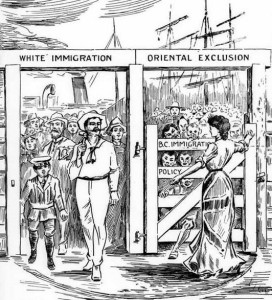 That racial chasm that yawns eternally in our midst’: the British empire and the politics of Asian migration, 1900–14 by Cornelis Heere
That racial chasm that yawns eternally in our midst’: the British empire and the politics of Asian migration, 1900–14 by Cornelis Heere
In recent years, the study of the networks, ideas and identities that bound the ‘British world’ together has proved a rich field of enquiry in imperial history. This article seeks to apply those insights to an issue that dominated much of Britain’s relations with its settler colonies before the First World War: the controversies surrounding the exclusion of Asian migrants. Racial exclusion has garnered a great deal of scholarly attention in recent years. This article builds on that historiography, but also questions its inattention to the British connection, and hence to considerations of imperial power. It analyses how the debate on immigration served as a canvas on which advocates and detractors of exclusion could paint competing concepts of empire, and seeks to understand how policymakers attempted to manage the migration question through a range of spatial and diplomatic solutions. It will attempt, in sum, to show how a global empire dealt with the problems of a world that seemed increasingly divided along racial lines.
A man called Mahaffy: an Irish cosmopolitan confronts crisis, 1899–1919 by Tomás Irish
This article examines the last twenty years of the life of one of Ireland’s most controversial scholars, the polymath John Pentland Mahaffy. Mahaffy’s name still has wide resonance in Irish historiography owing to his interventions in Irish cultural politics in the decades before 1919. He is frequently seen as an ‘anti-Irish’ figure. This article places Mahaffy in the wider context of international scholarship of the late Victorian era, arguing that he was a cosmopolitan whose overriding concern was not Ireland, or even Britain, but the fracturing of the republic of letters.
‘Per peli e per segni’. Muster rolls, lists and notes: practical military records relating to the last Florentine ordinanze and militia, from Machiavelli to the fall of the Republic (1506–30) by Andrea Guidi
In Renaissance Florence, the militia force created by Machiavelli in 1506, then re-established in 1527–30, involved the production of two types of records: the low-level ‘practical’ records which documented the daily running of an army in the field, such as muster rolls, notes and lists; and the upper-level administrative records, such as the correspondence between governing bodies and military officers. An analysis of published and unpublished sources provides evidence of the importance of such documentary practices, and highlights the problems connected to the loss and preservation of low-level military records relating to Renaissance ordinanze and militia.
The chronology of the de Mortemer family of Wigmore, c.1075–1185, and the consolidation of a Marcher lordship by Ian Mortimer
The twelfth-century chronology of the de Mortemer (later Mortimer) family of Wigmore has proved a difficult and confusing subject. In particular, most scholars have accepted the Complete Peerage genealogy, which incorrectly posits the existence of two distinct lords called Hugh between 1104 and 1181. Here, the English sources are reconsidered alongside independent Norman evidence, resulting in a more robust genealogy and a better context for understanding how the de Mortemers shifted their position from being primarily a Norman family with English and Welsh interests (which they neglected) to being primarily an English one with Norman and Welsh responsibilities (which they did not).
